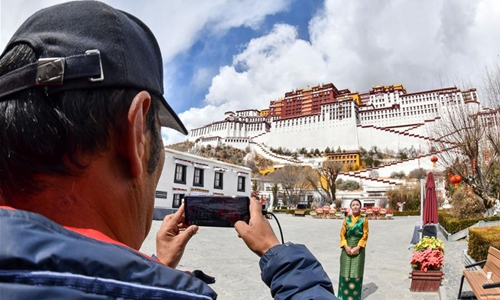Project of recording Tibetan billboards and street signs attracts interest on Chinese social media
Source:Global Times Published: 2020/6/2 17:23:41

A tour guide speaks during a live streaming tour in the Potala Palace, a UNESCO world heritage, in Lhasa, southwest China's Tibet Autonomous Region, March 1, 2020. The Potala Palace, a landmark in southwest China's Tibet Autonomous Region, held a live streaming tour session Sunday, the first time in its over 1,300-year history. (Xinhua/Chun La)
A plan aimed at preserving the beauty of traditional Tibetan calligraphy by photographing old-style billboards and notices on streets in Southwest China's Tibet Autonomous Region has captured the attention of netizens on Chinese social media in May.
A user of China's Twitter-like Sina Weibo who goes by the handle "Gaofantai" has carried out the campaign for more than a month, during which he has collected more than 100 photos from netizens in the region who have snapped photos of Tibetan writing scattered across the cities and towns of Tibet.
" 'Tibetan characters on streets' will be a long-term project for us and we will keep at it as long as possible," Gaofantai posted on Sina Weibo.
"We hope to record old billboards, notices and menus that are still used by ordinary people in Tibet. It will be better if this writing is handwritten or embroidered."
The user also called on netizens to also take photos of old printed materials such as books and newspapers that they feel embody the exquisiteness of Tibetan calligraphy.
On Friday, Gaofantai posted an article on the Sina Weibo account of 3type, a character font company, explaining why he launched the project.
"In Shanghai, Hong Kong, Berlin, Cairo and other cities, a considerable number of lovers of writing are engaged in the collection and arrangement of street graffiti, but we did not find that there are any individuals or groups collecting these works in Tibet, even though Tibetan calligraphy culture is very rich," the article said.
The development of the Tibetan script can be divided into five stages, with the earliest form possibly dating back to the 8th century BC, according to some scholars.
Common and traditional plaques for stores in Tibet are written in three languages: Chinese, English and Tibetan. Some of these plaques photographed by netizens have interesting stories behind them.
One photo shows a monument a person erected for a puppy that they had run over and killed in the street.
Next to a picture of the puppy painted on the monument is an inscription in Tibetan that, according to a note under the photo from Gaofantai, reads, "This monument invites passersby to pray for the dog and pay off the perpetrator's sin as soon as possible."
Some netizens have expressed their support for what they feel is a meaningful project.
"When I visited Tibet and passed by these streets, I ignored all this gorgeous street art. Please update with new works. I cannot wait to admire them," wrote one.
Posted in: ART,PHOTOGRAPHY